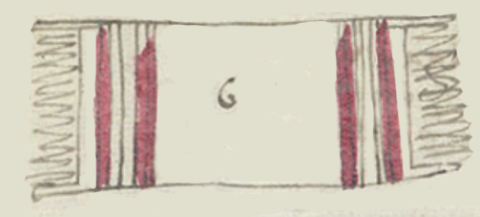frezada (CST40)
This painting of the simplex glyph for the term frezada (blanket) shows a horizontal, rectangular, fringed and striped blanket in a horizontal presentation. The companion text explains that this one was one of six blankets purchased for priests who “ruled” in the town (apparently in the past), according to Kevin Terraciano’s study (Codex Sierra, 2021, 158).
Stephanie Wood
Our Online Nahuatl Dictionary has various examples of the use of the term frezada, which can also be spelled frazada, but rarely is, at least in New Spain. These examples are sometimes accompanied by references to sheets or mattresses, but one was a horse blanket. The orthography of this vocabulary term varies widely when written by Nahua tlacuilos: preçada, brezada, fleçada, bleçala, and freçada. See below for glyphs that include people wrapped in blankets.
Stephanie Wood
1550–1564
Jeff Haskett-Wood
cobijas, textiles, lecho

frezada (a loanword from Spanish that entered Nahuatl, also spelled frazada), a blanket, https://nahuatl.wired-humanities.org/content/frezada
frezada o frazada
Stephanie Wood
Códice Sierra-Texupan, plate 40, page dated 1561. Origin: Santa Catalina Texupan, Mixteca Alta, State of Oaxaca. Kevin Terraciano has published an outstanding study of this manuscript (Codex Sierra, 2021), and in his book he refers to alphabetic and “pictorial” writing, not hieroglyphic writing. We are still counting some of the imagery from this source as hieroglyphic writing, but we are also including examples of “iconography” where the images verge on European style illustrations or scenes showing activities. We have this iconography category so that such images can be fruitfully compared with hieroglyphs. Hieroglyphic writing was evolving as a result of the influence of European illustrations, and even alphabetic writing impacted it.
https://bidilaf.buap.mx/objeto.xql?id=48281&busqueda=Texupan&action=search
The Biblioteca Digital Lafragua of the Biblioteca Histórica José María Lafragua in Puebla, Mexico, publishes this Códice Sierra-Texupan, 1550–1564 (62pp., 30.7 x 21.8 cm.), referring to it as being in the “Public Domain.” This image is published here under a Creative Commons license, asking that you cite the Biblioteca Digital Lafragua and this Visual Lexicon of Aztec Hieroglyphs.





